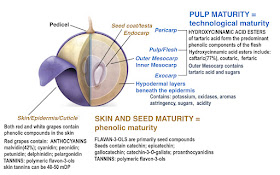What peaked my interest was the tool used called Berry Sensory Assessment (BSA), so this blog is about BSA. So while I began with reading the AJEV article, that took me on a slight digression involving BSA. I came across a great introductory slide deck uthored by Jacques Rousseau called Berry sensory analysis, a simple tool for maturity assessment.2
What are we doing when we taste a grape for maturity? There are two types of grape maturity: pulp maturity or technological maturity and seed maturity or phenolic maturity. The following illustration is color coded blue for pulp maturity and brown for seed maturity.3 The BSA relies on:
- Visual Examination
- Tactile Examination
- Taste Examination
References:
1. Jun Niimi, Paul K. Boss, David Jeffery, Susan E. P. Bastian, Linking Sensory Properties and Chemical Composition of Vitis vinifera cv. Cabernet Sauvignon Grape Berries to Wine, Am J Enol Vitic. July 2017 68: 357-368.
2. Jacques Rousseau, Berry sensory analysis, a simple tool for maturity assessment, BCWGC Conference, Penticton, July 18, 2017.
3. Vintage Direct 2.10 Making Sparkling Wine (Methode Champenoise)
Illustration is from Dunsford, P.A. and Sneyd, T.N. 1989. Pressing for quality. In: Proceedings of the Seventh Australian Wine Industry Technical Conference.



No comments:
Post a Comment